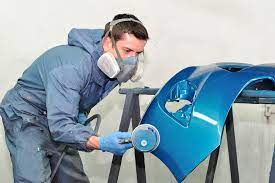Car paint is an essential component of a vehicle’s overall appearance, providing both aesthetic and protective benefits. Understanding the different types of paint and their specific uses can help car owners make informed decisions when it comes to maintaining their vehicles. In this article, we’ll take a comprehensive look at the various types of car paint, their purposes, benefits, and usage guidelines, as well as some of the history behind their invention.
Introduction to Car Paint
Car paint is a liquid coating applied to the body of a vehicle, which dries to form a hard, protective shell. The paint is made up of a combination of pigments, binders, and solvents, which give it its color, durability, and ability to adhere to the metal or plastic surface of the car. Car paint is available in a wide range of colors and finishes, from glossy to matte, and is often applied in multiple layers for optimal durability and appearance.
Types of Car Paint
One of the most popular types of car paint is called “Acrylic Enamel”. This type of paint is a type of alkyd paint made with an acrylic resin. It’s known for being easy to apply, dries quickly and to provide a hard and glossy finish. This is a common choice for older cars or vehicles that are in need of a paint job that needs to be done quickly.
Another type of paint is called “Acrylic Lacquer”. This paint uses an acrylic resin in a lacquer base to provide a glossy finish. This type of paint is known for being easy to work with and quick to dry. However, it is also more prone to cracking and fading than other types of paint.
“Urethane” paint is another option which is a type of polyurethane paint, known for its durability and resistance to fading and chipping. This paint is more difficult to work with than other types of paint and requires a specialized spray gun and techniques to apply, but it will provide a long-lasting finish. This type of paint is a popular choice for newer cars and high-end vehicles.
A newer paint technology is “Water-based paint” which is also called “Hydrochromic” paint. This type of paint uses water as the primary solvent rather than the traditional petrochemical-based solvents. Water-based paint is more environmentally friendly and provides a durable finish. It also tends to be less toxic than other types of paint and has a lower VOC (volatile organic compounds) emissions. This type of paint is used more frequently in recent years.
Benefits of Car Paint
Car paint is an essential component of a vehicle’s overall appearance, providing both aesthetic and protective benefits. The benefits of car paint include:
- Protecting the vehicle from rust and corrosion
- Enhancing the overall appearance of the car
- Increasing the value of the vehicle
- Providing a barrier against environmental elements, such as UV rays and pollutants
- Making it easier to clean the car
Using Car Paint
When using car paint, it is important to take the necessary precautions to ensure that the paint job is done correctly and safely. Some guidelines to follow include:
- Always wear protective clothing, such as a respirator mask, goggles, and gloves
- Work in a well-ventilated area to avoid inhaling paint fumes
- Take the necessary steps to prepare the car’s surface, such as sanding and cleaning, before applying the paint
- Follow the manufacturer’s instructions for mixing and applying the paint
- Allow the paint to dry completely before applying additional layers or polishing
Precautions
Be aware that the fumes and dust of the paint can be harmful so always work in a well-ventilated area and wear the necessary protective gear
Be careful when using solvents, as they are flammable and can cause skin irritation
Make sure the car is properly protected during the painting process to avoid any damage to the paint job
Avoid exposing the car to the elements or washing it for at least 24 hours after the paint has been applied to allow it to dry completely
History of Car Paint
The history of car paint can be traced back to the early days of the automobile industry, when cars were first being mass-produced. Initially, cars were painted using a variety of methods, such as brushing and rolling, which resulted in a less-than-perfect finish.
The invention of the spray gun in the 1920s revolutionized the car painting process, making it much easier and more efficient to apply the paint. This led to the development of new paint technologies, such as acrylic enamel and urethane, which provided a much higher-quality finish.
In recent years, the focus has been on environmental-friendly paint, with the development of water-based paints and the use of fewer toxic ingredients. Additionally, the paint technology has been developed to better withstand harsh climates and weather conditions, as well as resistance to fading and chipping.
Conclusion
Car paint is an essential component of a vehicle’s overall appearance, providing both aesthetic and protective benefits. Understanding the different types of paint and their specific uses can help car owners make informed decisions when it comes to maintaining their vehicles. The purpose of car paint is to protect the vehicle from rust and corrosion, enhance the overall appearance, increase the value of the vehicle, and provide a barrier against environmental elements. It is important to use the right type of paint, follow the manufacturer’s instructions and use necessary precautions when applying the paint. The paint technology has been developed to be more environmentally friendly and resistant to harsh weather conditions, adding further advantages for users.



